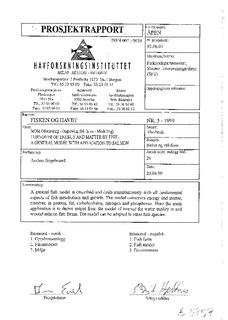| dc.description.abstract | The fish model described in this paper is quite general and deals simultaneously with all
fundamental aspects of fish metabolism and growth. The model conserves energy and
matter, resolved in protein, fat, carbohydrates, nitrogen and phosphorus. Here the main
application is to derive output from the model of interest for water quality in and around
fish farms. Thus, oxygen consumption due to fish respiration and emissions of various
biologically active dissolved substances from a fish farm are derived for given fish stock,
food composition, feeding rate and temperature. The fluxes of particulate organic matter
(uneaten food and faeces) from a farm are also derived. The model can be used for many
purposes. It can be used to find food compositions fulfilling different objectives, for
instance, minimising the emission of plant nutrients or food costs. It should be possible to
adapt the model to other fish species for use in, for instance, models of natural populations
of fish interacting with each other. | en |
